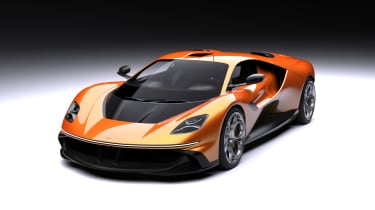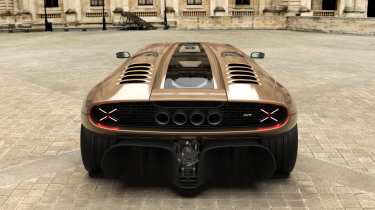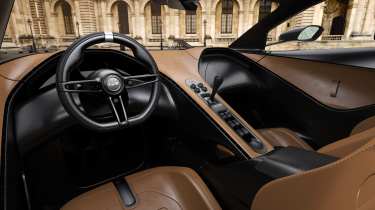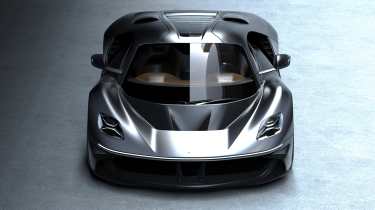Garagisti GP1 is a V12 manual rival to the GMA T.50
There are more manual V12 hypercars in the works than city cars these days. The GP1 is a beautiful thing, but will it happen?

Joining the market for analogue hypercars that’s seemingly swelling in size beyond that of small affordable city cars, is Garagisti & Co. With a name inspired by 1950s F1 racers and designs on Pagani and Koenigsegg-like success, Garagisti has presented the GP1, a 6.6-litre V12-engined, manual-transmissioned hypercar very much of the old school.
Analogue is a formula that’s worked for Gordon Murray Automotive in terms of appeal and sales while the tech-heavy titans from Maranello and Woking have struggled to stir the souls (and wallets) of hypercar collectors. But it joins a growing range of optimistic newcomers, adding to the ranks of dreamy but difficult-to-realise analogue hypercars. Can this one actually be brought to fruition?
One way it hopes to make the GP1 a reality is by calling upon a so-called ‘coalition of specialists’. The V12 engine is set to be developed by Italtecnica Srl, is touted as good for 789bhp at 9000rpm (note that’s where that power comes in, not the redline) and 516lb ft. Sending that power to the rear wheels will be a six-speed manual transmission from Xtrac.
Italtecnica Srl is an Italian motorsport and powertrain specialist responsible for the V6 engine in the Totem Alfa Romeo Giulia evocation, engines for Kimera and Automobili Amos and the V8 in the Nardone Porsche 928 restomod.
> Pagani Huayra Codalunga v Huayra Roadster BC – £10m of hypercar siblings go head-to-head
The chassis is a carbon monocoque developed by Dexet Technologies, the team behind the GTO Engineering Squalo’s chassis. It’ll also be handling the car’s aerodynamic development. Brembo and Öhlins meanwhile, will be other prominent partners on the project. The target weight for the car is in the region of 1000kg (dry) which isn’t beyond the realms of achievability given GMA got below that figure at the kerb with the T.50. The car is intended to be a competent track car but primarily, an appealing grand touring and driver’s car for the road.
The coalition of specialists continues into the design of the car, with ex-Bugatti and Rimac designer Angel Guerra on the pen. Dexet will be across the design ensuring the aerodynamic concept is sound, with ground effect claimed to play an important role in the car’s platform. As much is obvious from those two enormous venturi tunnels.
Purely in terms of design, it’s said to be at once a spiritual successor to Horacio Pagani’s carbon-bodied Lamborghini Countach Evoluzione and inspired by icons of the ‘80s, ‘90s and 2000s. We can see visual cues that put us in mind of everything from the Mercedes C111 Concept (that rear end) to the 2016 Ford GT (that angular side intake). There’s a bit of LaFerrari in the lower area of the nose, a bit of 918 Spyder in the front lights, a bit of AMG One in that carbon area forward of the windscreen. Is there a bit of Maserati Bora and DeTomaso Pantera in the silhouette, too?
> GMA T.50 v McLaren F1 – has the best car in the world been dethroned by its successor?
Yet for all of these elements that are reminiscent of other cars, the GP1 doesn’t engage that cynical part of your brain as a facsimile would. There’s a cohesion and originality to the sum of these disparate parts. Perhaps all the familiar cues are evidence that there are just so many hypercars and supercars now, it’s hard to be original. Like how it’s hard now to write an original song.
There’s familiarity to the inside too with more than a little of the Porsche Carrera GT’s swooping central waterfall, with the lever for that Xtrac gearbox high up it, close to the steering wheel. Otherwise it’s minimalist and sculptural, with all visible surfaces either a glazing of leather or carbonfibre, with the vents integrated seamlessly. There are no visible screens either.
Garagisti plans on making 25 examples with each starting from £2.45million plus local taxes. Each car will obviously be highly customisable and for the first 12 buyers, an all-inclusive ‘Open Doors’ programme is there to be enjoyed, with gatherings and up-close access to all who are working on it as the car is formed. Given those first 12 buyers are tantamount to financiers, getting an inside look at where their deposit money is going is certainly a way to settle nerves.
What there are no details of yet is where the car will be built and indeed what the timeline is in terms of when prototypes will be up and running and when production, or deliveries, are set to begin. At the moment we have some renderings of a very pretty car, some claims for specs and not a lot else. Not much, we can imagine, has yet sprung into the third dimension from this clean sheet of paper.
No matter the concept, startup hypercar manufacturing is a risky business to go into. What’s the old saying? The quickest way to become a millionaire is to be a billionaire who gets into the car business. In concept though, the GP1 sounds awfully appealing. Let’s hope it makes it out of photoshop and onto the road.







